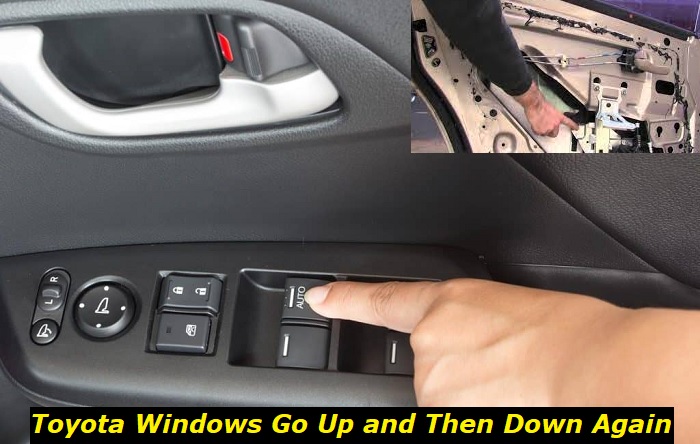There's nothing more annoying than a car window that does not open or close all the way in a Toyota. It goes more infuriating when it goes up and then down halfway. This exposes you to pollutants in the air, dust, snow, rain, and other outside elements while you are driving, which can pose a danger to you, your passengers, and other road users. Likewise, this also invites criminal elements toward your vehicle, such as theft.
Electrical gremlins highlights
- Level of urgency:medium
- DIY inspection:impossible
- DIY repair:impossible
- Can you drive?yes
- Price for repairs:$0 - $300
- Symptoms:glitch, unusual behavior, temporary problem
- Ways to solve:check the battery voltage, check wiring and connections, take it to a professional mechanic

Most Common Causes of the Problem
According to reports, forums, mechanics, and customer complaints, this kind of problem found in Toyota vehicles usually stems from the following factors:
1. Too Much Friction Around the Window Frame
The most common cause of the Toyota window going up and then going down halfway is having too much friction along its path within the window frame. So, the first thing that you should always do when dealing with this situation is to inspect the area around the window frame for signs of excessive friction. This could be caused by debris lodged inside or worn-out rubber seals that have become too dry and hard over time.
In most cases, dirt and dust particles can accumulate on the window frame over time and create a rough surface for the glass to move against. Make sure to regularly clean out any built-up residue from around the frame in order to keep it smooth and working properly.
Depending on the level of dirt build-up in your window, the remedy may be as easy as removing the stuck debris along the way of the window by hand or with a soft cloth. However, if the contamination is more serious, you may have to remove the interior door panel for a more thorough cleaning.
You can also use a silicone lubricant after cleaning in order to reduce friction even further. This solution should be applied throughout the entire area of contact between the window panel and its frame, as well as any other parts that come into contact with it during operation. Doing so will help ensure the optimal performance of your power windows.
Additionally, if there is too much pressure being applied to the window frame when it is being opened or closed, this can also cause wear and tear. Make sure not to press too hard on the window panel so that it operates properly.
Lastly, if you find any worn-out parts while inspecting the frame such as worn rubber seals, replace them with new ones in order to restore the full operation of your power windows. Doing so will greatly reduce the amount of friction present in your window and help you avoid more expensive repairs arising from further damage.
2. Faulty Window Regulator
A faulty window regulator may be the reason why your Toyota's power window goes up but comes down again halfway. To diagnose whether or not the window regulator has become faulty and already needs to be replaced, you can visually inspect it for signs of wear and tear, or use a multimeter tool to check its continuity.
Start by removing the interior door panel and inspecting the window regulator for any broken parts or loose connections. Any sign of excessive damage means the part is already due for a replacement.
If it turns out that the component is simply dirty, then you can clean it with a rag dampened with rubbing alcohol while being careful not to allow any liquid into the electrical connections. Since dirt buildup on the internal components of the regulator may affect its performance, cleaning it regularly is a good idea.
However, if after inspection and cleaning there are still issues with your Toyota's power windows, then you should consider replacing the window regulator. Be aware that, depending on your car's model and year, you may need to buy a new window motor as well if it is part of the same assembly.
While it is possible to install a window regulator on your own with simple tools, professional installation by a qualified technician is highly recommended in order to ensure the proper functioning and prevent further damage to other parts.
3. Malfunctioning Power Window Motor
If the window of a Toyota vehicle goes up but then goes down again halfway, this could potentially be a sign that the power window motor is faulty. To diagnose whether or not the power window motor needs to be replaced, it is recommended to perform a visual inspection of the motor and its connection points.
If all connections appear secure and the motor itself appears undamaged, then testing with a multimeter will give an indication as to whether or not the power window motor should be replaced.
Testing with a multimeter can be done by putting it on voltage setting and sensing at the motor's connection points. If no voltage is sensed within its circuitry, then the power window motor should be replaced.
It is also important to note that if the window power motor has been working fine for some time, but then starts having issues, it could be due to a faulty switch, wire, or ground connection. It is best to check these components before replacing the power window motor.
Moreover, if the power window motor continues to be noisy after replacement, it could indicate an issue with the roller guide. In this case, the roller guide should be inspected and replaced as necessary.
Ultimately, diagnosing and fixing any issues with the power window motor is best done by a professional mechanic. They will be able to systematically diagnose and repair the problem with the power window motor as quickly and cost-effectively as possible.
A faulty power window motor can be an annoying problem for any vehicle owner. Although it may seem like a relatively minor issue on the surface, getting it fixed as soon as possible is important in order to prevent further damage and ensure the safe operation of the car's windows.
4. Failing Switches
When a Toyota vehicle's power window goes up but then comes back down halfway, the cause could be an issue with the switch. To diagnose this problem, manual testing and the use of a multimeter are once again recommended.
A manual test involves evaluating the switch for any signs of cracking or electrical short in its button and casing. If you see any signs of damage, that's a good indication that the switch is already due for a replacement.
With a multimeter set to ohms, you can confirm that there is continuity in the circuitry of the switch, too. If a voltage isn't found, then it could be that the switch has gone bad and will need replacement in order to fix the power window issue.
As an extra measure of troubleshooting, check for any loose connections in the wiring harness of both the door switch circuit and the power window motor connection. Make sure that all terminals are secure and free from corrosion or other signs of damage.
A poor connection can cause intermittent problems like this one with the power window going up but not coming down again. Tightening these connections or replacing them if necessary should solve the issue.
If all else fails, seek professional assistance from a qualified technician who can provide further evaluation of the problem.
Caring Tips for the Toyota Power Windows
General tips for taking care of power windows include the following:
- Avoid irresponsible use like playing with the buttons of your power windows by making them open and close at quick intervals repeatedly.
- Check for rust or dirt build-up around the window guides and seals every once in a while.
- Keep the tracks clean from debris buildup so that they can slide freely up and down without obstruction.
- Be sure to lubricate the track mechanism periodically using an aerosol lubricant spray specifically designed for automobile window mechanisms. Doing so will help prevent unnecessary stress on the window regulator and motor, allowing them to last longer.
- If you are interested in learning more about the Toyota power windows, a number of online tutorials and videos can be found with detailed instructions on how they work and how to diagnose potential issues.
- Reputable automotive forums filled with knowledgeable members are a great source of information and advice when it comes to troubleshooting problems related to your vehicle's power windows.
- Ultimately, understanding the basics, as well as proper maintenance, is key for ensuring that you get years of trouble-free operation from your Toyota's power windows.
Conclusion
With proper maintenance and regular checkups, most issues related to the power window system can be avoided such as the underlying issue in this article.
However, when faced with specific malfunctions such as those involving faulty electrical components, it is important to have the issue properly diagnosed and addressed by an automotive technician or mechanic in a timely manner.
About the authors
The CarAraC research team is composed of seasoned auto mechanics and automotive industry professionals, including individuals with advanced degrees and certifications in their field. Our team members boast prestigious credentials, reflecting their extensive knowledge and skills. These qualifications include: IMI: Institute of the Motor Industry, ASE-Certified Master Automobile Technicians; Coventry University, Graduate of MA in Automotive Journalism; Politecnico di Torino, Italy, MS Automotive Engineering; Ss. Cyril and Methodius University in Skopje, Mechanical University in Skopje; TOC Automotive College; DHA Suffa University, Department of Mechanical Engineering






Add comment